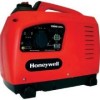Honeywell HW1000i Owners Manual - Page 28
Adding Fuel - parts manual
 |
UPC - 894190002186
View all Honeywell HW1000i manuals
Add to My Manuals
Save this manual to your list of manuals |
Page 28 highlights
Engine Fuel Engine Fuel NOTICE Oxygenated fuels can damage paint and plastic. Be careful not to spill fuel when filling the fuel tank. Damage caused by spilled fuel is not covered under warranty. 3. Remove the fuel cap. Ethanol (ethyl or grain alcohol) Gasoline containing more than 10% ethanol by volume may cause starting or performance problems. Gasoline containing ethanol may be marketed under the name "Gasohol". Methanol (methyl or wood alcohol) Gasoline containing methanol must contain co-solvents and corrosion inhibitors to protect fuel system. Gasoline containing more than 5% methanol by volume may cause starting and/or performance problems and may damage metal, rubber and plastic parts of fuel system. MTBE (methyl tertiary butyl ether) You can use gasoline containing up to 15% MTBE by volume. TABLE 6. Oxygenated Fuel Types Adding Fuel NOTICE To avoid damage to engine, never use stale or contaminated gasoline or oil/gasoline mixture. Avoid getting dirt or water in fuel tank. Use fresh gasoline with a pump octane rating of 87 or higher. DANGER Fuel and fuel vapors are extremely flammable and explosive under certain conditions. NEVER fill fuel tank while engine is running. Turn generator OFF and allow to cool before filling with fuel. 1. Stop the generator if the engine is running. Allow to completely cool. 2. Place the generator on a flat, level surface. FIGURE 29: Adding Fuel (HW2000i Model) 4. Slowly pour gasoline into the fuel tank. Be careful not to overfill. FIGURE 30: Maximum Fuel Level DANGER Be careful not to spill fuel when refueling. Spilled fuel or fuel vapor may ignite. If any fuel is spilled, be sure area is dry before starting engine. 5. Reinstall the fuel cap and tighten. FIGURE 31: Reinstall Fuel Cap NOTE: Occasional, light spark knock, "pinging", or rattling noise is normal while operating under heavy loads. If spark knock, pinging, or rattling occurs at a steady engine speed, under normal load, drain the fuel (page 27) and refill with fresh gasoline. If the noise persists, see an authorized generator dealer. NOTICE Running the engine with persistent spark knock or pinging can cause engine damage. Warranty does not cover parts damaged by misuse. 22 www.honeywellgenerators.com HW1000i / HW2000i Inverter Generator Owner's Manual















